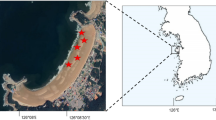Abstract
Pelagic eggs of the scaled sardine Harengula pensacolae (Goode and Bean), have been hatched and reared in the laboratory for the first time. Larvae were reared in two 75 l aquaria under constant illumination, at an average temperature of 26.2°C. Zooplankton collected in a 35 μ mesh net was fed to the newly hatched larvae, and the diet was supplemented later with Artemia salina nauplii and a pelleted food. Larvae hatched at 4 mm TL (total length), and metamorphosed about 25 days later at 25 to 30 mm TL. Survivors averaged 76 mm TL 100 days after hatching. Of the 500 incubated eggs, 2.8% survived until 20 days, after which no significant natural mortality occurred. Sources of natural mortality included starvation, a copepod parasite (Caligus sp.), and injuries from contact with the sides of the tank. Larvae began feeding at 4.5 mm TL on copepod nauplii averaging 62 μ in body width. Scaled sardines were photopositive throughout the larval stage.
Similar content being viewed by others
Literature cited
Blaxter, J. H. S.: Herring rearing — 4. Rearing beyond the yolk sac stage. Mar. Res. 1, 18 pp. (1962).
—: Rearing herring larvae to metamorphosis and beyond. J. mar. biol. Ass. U.K. 48, 17–28 (1968).
—: Experimental rearing of pilchard larvae, Sardina pilchardus. J. mar. biol. Ass. U.K. 49, 557–575 (1969).
Braum, E.: The survival of fish larvae with reference to their feeding behavior and the food supply. In: The biological basis of freshwater fish production, pp 113–131. Ed. by S. D. Gerking. New York: J. Wiley & Sons Inc. (1967).
Klima, E. F.: Aspects of the biology and the fishery for Spanish mackerel, Scomberomorus maculatus (Mitchill), of Southern Florida. Tech. Ser. Fla St. Bd Conserv. 27, 1–39 (1959).
Richards, W. J. and B. J. Palko: Methods used to rear the thread herring, Opisthonema oglinum, from fertilized eggs. Trans. Am. Fish. Soc. 98, 527–529 (1969).
Riley, J. D. and G. T. Thacker: Marine fish culture in Britain. 3. Plaice [Pleuronectes platessa, (L.)] rearing in closed circulation at Lowestoft, 1961. J. Cons. perm. int. Explor. Mer 28, 80–90 (1963).
Rivas, L. R.: Family Clupeidae. Genus Harengula. In: Fishes of the western North Atlantic. Part 3. Soft-rayed bony fishes, pp 386–396. Mem. Sears Fdn mar. Res. 1. 1963.
Rosenthal, H.: Parasites in larvae of the herring (Clupea harengus L.) fed with wild plankton. Mar. Biol. 1, 10–15 (1967).
—: Untersuchungen über das Beutefangverhalten bei Larven des Herings Clupea harengus. Mar. Biol. 3, 208–221 (1969).
Schumann, G. O.: Some aspects of behavior in clupeid larvae. Rep. Calif. coop. oceanic Fish. Invest. 10, 71–78 (1965).
Author information
Authors and Affiliations
Additional information
Communicated by G. L. Voss, Miami
Contribution No. 149, Bureau of Commercial Fisheries Tropical Atlantic Biological Laboratory, Miami, Florida 33149, USA.
Rights and permissions
About this article
Cite this article
Houde, E.D., Palko, B.J. Laboratory rearing of the clupeid fish Harengula pensacolae from fertilized eggs. Marine Biology 5, 354–358 (1970). https://doi.org/10.1007/BF00346902
Accepted:
Issue Date:
DOI: https://doi.org/10.1007/BF00346902




